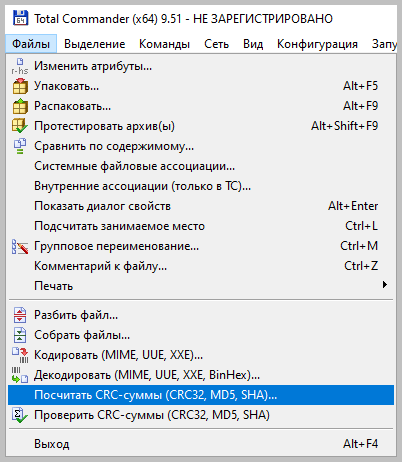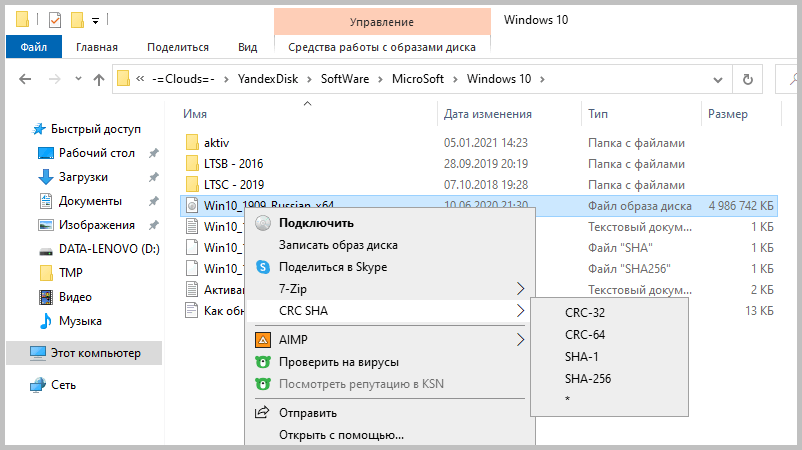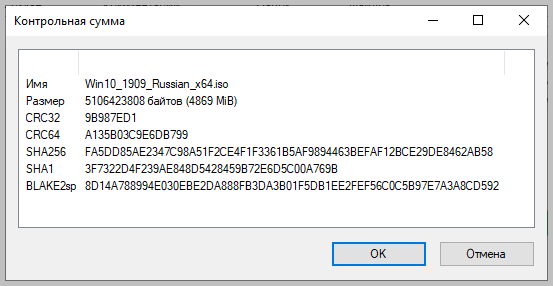- Availability and description of the File Checksum Integrity Verifier utility
- Summary
- INTRODUCTION
- Syntax
- Commands
- Options
- Example usage
- How to generate and verify hash values for a Microsoft Download
- How to verify the hash values for the files in the Windows directory and in all sub-directories
- Как узнать контрольную сумму файла в Windows
- Для чего нужны контрольные суммы
- Как вычислить контрольную сумму он-лайн
- Как узнать контрольную сумму файла в Windows
- Файловый менеджер Total Commander
- Файловый архиватор 7-Zip
- Как подсчитать контрольную сумму файла из консоли Windows
- Считаем контрольную сумму в PowerShell
- Какой алгоритм вычисления контрольных сумм самый правильный
- Выводы
Availability and description of the File Checksum Integrity Verifier utility
Summary
The File Checksum Integrity Verifier (FCIV) is a command-prompt utility that computes and verifies cryptographic hash values of files. FCIV can compute MD5 or SHA-1 cryptographic hash values. These values can be displayed on the screen or saved in an XML file database for later use and verification.
INTRODUCTION
This article discusses the File Checksum Integrity Verifier (FCIV) utility.
Warning The Microsoft File Checksum Integrity Verifier (FCIV) utility is an unsupported command-line utility that computes MD5 or SHA1 cryptographic hashes for files. Microsoft does not provide support for this utility. Use this utility at your own risk. Microsoft Product Support Services (PSS) cannot answer questions about the File Checksum Integrity Verifier utility.
The File Checksum Integrity Verifier (FCIV) utility can generate MD5 or SHA-1 hash values for files to compare the values against a known good value. FCIV can compare hash values to make sure that the files have not been changed.
With the FCIV utility, you can also compute hashes of all your critical files and save the values in an XML file database. If you suspect that your computer may have been compromised, and important files have been changed, you can run a verification of the file system files against the XML database to determine which files have been modified.
The FCIV utility runs on Microsoft Windows 2000, Windows XP, and Windows Server 2003.
The FCIV utility has the following features:
Supports MD5 or SHA1 hash algorithms (The default is MD5.)
Can output hash values to the console or store the hash value and file name in an XML file
Can recursively generate hash values for all files in a directory and in all subdirectories (for example, fciv.exe c:\ -r)
Supplies an exception list to specify files or directories to hash
Can store hash values for a file with or without the full path of the file
To obtain the FCIV utility, follow these steps:
In Windows Explorer, create a new folder that is named FCIV.
The following file is available for download from the Microsoft Download Center:

Release Date: May 17, 2004
For additional information about how to download Microsoft Support files, click the following article number to view the article in the Microsoft Knowledge Base:
119591 How to Obtain Microsoft Support Files from Online Services Microsoft scanned this file for viruses. Microsoft used the most current virus-detection software that was available on the date that the file was posted. The file is stored on security-enhanced servers that help to prevent any unauthorized changes to the file.
In the File Download dialog box, click Save, and then save the file to the FCIV folder that you created in step 1.
When the download is completed, click Close.
In the FCIV folder, double-click Windows-KB841290-x86-ENU.exe.
Click Yes to accept the license agreement.
Click Browse, click the FCIV folder, and then click OK.
Click OK to extract the files.
When the file extraction is completed, click OK.
Add the FCIV folder to the system path.
To start a command prompt, click Start, click Run, type cmd in the Open box, and then click OK.
Type fciv.exe /?, and then press ENTER.
Note If FCIV was installed to the C:\FCIV directory, type set path=%path%;c:\fciv to add it to the system path in a command shell.
Syntax
Commands
-add file | dir: Compute the hash and send it to an output device (default screen). The dir parameter has the following options:
-type: Specify file type. For example, -type *.exe.
-exc file: Do not compute these directories.
-wp: Do not store the full path name. (By default, FCIV stores the full path name.)
-bp: Remove the base path from the path name of each entry.
-list: List entries in the database.
-v: Verify hashes. The -v option has the following option:
-bp: Remove the base path from the path name of each entry.
-?, -h, or -help: Open extended help.
Options
-md5, -sha1, or -both: Specify hash type. (By default, MCIV uses -md5.)
-xml db: Specify database format and name.
Note When you use the -v option to verify a hash, FCIV also sends a return error code to indicate whether a hash is verified. A zero (0) indicates success, and a 1 indicates failure. With the return error code, you can use FCIV in automated scripts to verify hashes.
Example usage
To display the MD5 hash of a file, type the following command at a command prompt:
fciv.exe filename Note filename is the name of the file.
To compute a hash of a file, type a command line that is similar to any one of the following command lines:
fciv.exe c:\mydir\ myfile.dll
fciv.exe c:\ -r -exc exceptions.txt -sha1 -xml dbsha.xml
fciv.exe c:\ mydir -type *.exe
fciv.exe c:\ mydir -wp -both -xml db.xml
To list the hashes that are stored in a database, type a command line that is similar to the following command line:
fciv.exe -list -sha1 -xml db.xml
To verify a hash in a file, type a command line that is similar to any one of the following command lines:
fciv.exe -v -sha1 -xml db.xml
fciv.exe -v -bp c:\ mydir -sha1 -xml db.xml
The File Checksum Integrity Verifier (FCIV) utility can store entries in an XML database file. When FCIV is configured to store hash values in an XML database file, the hexadecimal hash values are stored in base64 encoded format. When you view the XML database directly, the base64 encoded representation of the hash value does not visually match the hexadecimal value that the console displays. FCIV decodes the base64 encoded hashes when it displays the contents of the database to the screen. Therefore, it displays the correct hexadecimal value.
The following example shows how FCIV computes the MD5 hash value for Ntdll.dll and displays it at the command prompt:
Here is the hash value for the same file that is base64 encoded and stored in an XML file by using the following command:
C:\WINDOWS\system32>fciv -add ntdll.dll -xml c:\temp\ntdll.xml
Here is the value that appears in the XML file that uses FCIV to list the contents.
Note It matches the value that was computed in the first example.
How to generate and verify hash values for a Microsoft Download
Download the file to a temporary directory (such as C:\Temp).
To extract the contents of the file, use the /x switch. Specify an output directory for the extracted files when you are prompted (such as C:\Temp\Files).
You can also use the /extract switch to extract the files without starting Setup.
For additional information about the /extract switch, click the following article number to view the article in the Microsoft Knowledge Base:
262841 Command-Line switches for Windows software update packages
The security update may be an IExpress package. If it is, see the following article in the Microsoft Knowledge Base about how to extract an IExpress package:
197147 Command-line switches for IExpress software update packages
To create a database for a single file and to save it to the C:\Temp directory, type the following command:
fciv.exe -add c:\temp\files\ filename.dll -wp c:\temp\files -XML c:\temp\ filename.XML
To verify the contents of the XML database against an installed file, type the following command:
fciv.exe -v -bp c:\installeddirectory -XML c:\temp\filename.XML Note installeddirectory is the location of the installed file.
Note When you use the -v option to verify a hash, FCIV also provides a return error code to indicate success (0) or failure (1) to verify a hash. Because of the return error code, you can use FCIV in automated scripts to verify hashes.
FCIV will confirm at the console if the hash values for the file matches the values that are stored in the XML database.
How to verify the hash values for the files in the Windows directory and in all sub-directories
You can also build a hash database of your sensitive files and verify them regularly.
To create the database and to save it to the C:\Temp directory, type the following command:
fciv.exe -add %systemroot% -r -XML c:\temp\windows-hashes.XML
To list the contents of the database to the console, type the following command:
fciv.exe -list -XML c:\temp\windows-hashes.XML
To verify the contents of the XML database against the current file system files, type the following command:
Как узнать контрольную сумму файла в Windows
При скачивании ISO образов и архивов больших размеров всегда есть вероятность получить «битый» файл. Во времена Dial-UP такое было сплошь и рядом. И хотя сейчас такое случается намного реже, чтобы убедиться, что перед вами «оригинальный» файл придумали контрольные суммы, которые вычисляются на основе содержимого и позволяют заметить несоответствие даже одного байта.
То есть, если вы измените один байт в проверяемом файле, то и контрольная сумма такого файла так же изменится.
Для чего нужны контрольные суммы
У контрольных сумм две задачи:
- Убедиться, что файл скачался корректно.
- Убедиться, что файл не был изменен злоумышленниками.
Зная контрольную сумму оригинала, можно проверить является ли ваша копия подлинной.
Как вычислить контрольную сумму он-лайн
Контрольную сумму можно проверить он-лайн. Но я не буду рекомендовать этот способ, так как если размер вашего файла несколько ГигаБайт, то это займет много времени и всегда есть вероятность ошибки при передаче файла. Кроме того делиться своими файлами со сторонними сервисами не правильно.
Как узнать контрольную сумму файла в Windows
Разумнее вычислить контрольную сумму локально на своем компьютере. Это быстро и конфиденциально. В этой статье я опишу несколько способов получения контрольных сумм, как с помощью сторонних программ, так и непосредственно с помощью самой операционной системы Виндовс.
Файловый менеджер Total Commander
Total Commander — это популярный файловый менеджер, работающий на платформах Microsoft Windows и Android. В нем есть встроенная функция вычисления контрольных сумм.
После чего вы можете выбрать один из алгоритмом вычисления контрольных сумм.
По-умолчанию Total Commander создает файл с именем проверяемого и с расширением по имени выбранного алгоритма расчета контрольной суммы.
Файловый архиватор 7-Zip
7-Zip — свободный, бесплатный файловый архиватор с высокой степенью сжатия данных. Он поддерживает несколько алгоритмов сжатия и множество форматов данных, включая собственный формат 7z c высокоэффективным алгоритмом сжатия LZMA.
Этот архиватор имеет встроенную функцию вычисления контрольных сумм. Запустить ее можно прямо из контекстного меню Windows:
Если выбрать «звездочку», то программа подсчитает сразу несколько контрольных сумм:
Полученные данные можно выделить и скопировать в текстовый документ.
Как подсчитать контрольную сумму файла из консоли Windows
Чтобы посчитать контрольную сумму совсем не обязательно устанавливать специальные программы. И если вы не пользуетесь упомянутыми выше, то можете рассчитать контрольную сумму прямо из командной строки операционной системы.
Например, чтобы посчитать контрольную сумму SHA1 с помощью утилиты CertUtil нужно запустить командную строку Windows 10, 8 или Windows 7 и ввести следующую команду:
Вот пример ее работы через несколько минут:
Считаем контрольную сумму в PowerShell
PowerShell — это средство автоматизации от Microsoft, с интерфейсом командной строки и языка сценариев, работает и включена в состав Windows 8 и новее.
Чтобы вычислить контрольную сумму файла необходимо выполнить команду Get-FileHash указав через пробел имя файла и алгоритм вычисления контрольной суммы:
Обратите внимание, что полный путь и имя файла лучше заключить в двойные кавычки.
По-умолчанию, если не указать тип контрольной суммы, то будет посчитана SHA-256.
Для алгоритмов вычисления контрольной суммы в Windows PowerShell поддерживаются следующие значения:
Для оформления вывода в виде списка можно использовать параметр | Format-List. Например:
Тогда результат работы будет выглядеть так:
Подробнее об использовании команды Get-FileHash можно прочитать на официальном сайте Microsoft — https://docs.microsoft.com/ru-ru/powershell/module/microsoft.powershell.utility/get-filehash
Какой алгоритм вычисления контрольных сумм самый правильный
MD5, SHA-1, SHA-256 и прочие – это разные алгоритмы хеш-функции. Хэши являются результатом работы криптографических алгоритмов, и представляют собой строку символов. Часто эти строки имеют фиксированную длину, независимо от размера входных данных.
MD5 самый быстрый, считается устаревшим, а SHA-256 имеет наименьшую вероятность коллизии, когда два разных файла имеют одинаковую контрольную сумму.
Для проверки целостности файла вам следует использовать тот, который предоставляет издатель. Если у вас на выбор есть несколько контрольных сумм, то лучше выбрать в следующей последовательности MD5, SHA-1, SHA-256, последний вариант является более предпочтительным.
Выводы
Если вы сомневаетесь в целостности скаченных файлов из интернета, особенно когда это касается оригинальных образов операционных систем, то проверьте их контрольную сумму. Сделать это можно как с помощью уже имеющихся у вас программ, так и воспользовавшись встроенными средствами операционной системы Windows.










